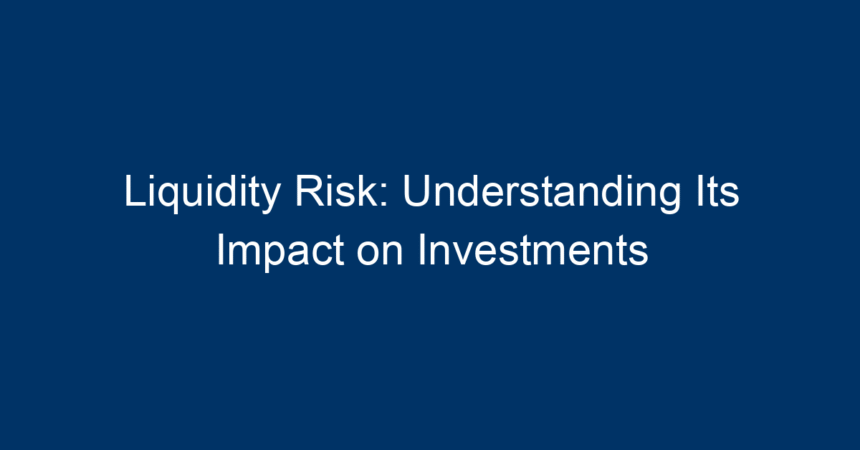In the fast-paced world of finance, investors are continually faced with varied risks that can impact their portfolios. Among these, liquidity risk stands out as a crucial factor that can influence investment decisions and outcomes. Often overlooked, liquidity risk is the possibility that an asset cannot be bought or sold quickly enough to prevent a loss or meet a financial obligation. For both seasoned investors and newcomers alike, understanding liquidity risk is essential in shaping a robust investment strategy.
What Is Liquidity Risk?
Liquidity risk is generally categorized into two types: funding liquidity risk and market liquidity risk.
Funding Liquidity Risk
Funding liquidity risk refers to a situation where an entity cannot meet its short-term financial obligations due to an inability to convert assets into cash quickly. For instance, if a hedge fund holds significant positions in illiquid securities, it may face challenges during market downturns when it needs to liquidate holdings for cash.
Market Liquidity Risk
Market liquidity risk, on the other hand, involves the inability to execute transactions in a timely and efficient manner without negatively impacting the asset’s price. When a market is considered illiquid, buying or selling substantial amounts of an asset can lead to price fluctuations. This is particularly evident in niche markets or during times of economic distress.
The Importance of Liquidity Risk in Investment Decisions
1. Asset Selection
Investors must consider liquidity risk when selecting assets for their portfolio. Stocks of large, well-established companies typically have higher liquidity than those of smaller firms. As a result, investing in small-cap stocks might offer higher potential returns, but they also come with greater liquidity risk. Understanding these dynamics enables investors to make more informed choices and align their asset selection with their risk tolerance.
2. Portfolio Management
Liquidity risk influences portfolio management strategies. Investors often need quick access to cash for emergencies or new investment opportunities. A portfolio heavily weighted in illiquid assets could restrict these opportunities. Diversifying the portfolio with liquid assets such as blue-chip stocks or high-quality bonds can mitigate this risk.
3. Market Conditions
Economic conditions can significantly affect liquidity risk. For instance, during a financial crisis, even typically liquid assets can become illiquid. Market volatility can cause investors to panic, leading to a shortage of buyers and sellers. Understanding the prevailing market conditions can help investors anticipate liquidity risks and take preemptive action.
Measuring Liquidity Risk
1. Bid-Ask Spread
One of the most common metrics for determining liquidity is the bid-ask spread, which is the difference between the price buyers are willing to pay for an asset and the price sellers are willing to accept. A narrower bid-ask spread indicates higher liquidity, while a wider spread suggests lower liquidity.
2. Trading Volume
Another important indicator is the trading volume of an asset. High trading volumes typically indicate a more liquid market, as they suggest that there are many buyers and sellers actively participating. Conversely, low trading volumes may indicate heightened liquidity risk.
3. Market Depth
Market depth refers to the market’s ability to sustain relatively large market orders without impacting the price of the asset significantly. A market with good depth will allow for easier buying and selling without large price fluctuations, thus minimizing liquidity risk.
Strategies to Mitigate Liquidity Risk
1. Diversification
Diversification is a foundational strategy for managing liquidity risk. By spreading investments across various asset classes, sectors, and geographical regions, investors can reduce the potential impact of liquidity crises. For example, holding a mix of stocks, bonds, and cash equivalents can provide a buffer during times of market stress.
2. Avoiding Overconcentration
Investing too heavily in a single asset or sector can expose investors to liquidity risk. If that asset declines in value or becomes difficult to sell, it could jeopardize the entire portfolio. Diversifying investments prevents overconcentration in any single security or market segment, thereby reducing risk.
3. Regular Portfolio Review
Frequent portfolio reviews allow investors to adjust their holdings based on changing market conditions and their personal financial situations. By regularly assessing liquidity risk, investors can make informed decisions about buying, holding, or selling assets to maintain their desired level of liquidity.
4. Holding Cash Reserves
Maintaining a portion of the portfolio in cash or cash-equivalent instruments can provide a safety net during liquidity events. Cash reserves allow investors to take advantage of potential buying opportunities while also ensuring they can meet short-term financial obligations.
The Role of Regulatory Frameworks
In recent years, regulatory bodies worldwide have recognized the importance of managing liquidity risk. For instance, the Basel III framework has established liquidity coverage ratios (LCR) and net stable funding ratios (NSFR) to ensure banks maintain sufficient liquidity. These regulations help promote overall market stability and can affect investment strategies, especially in the financial sector.
The Impact of Liquidity Risk on Market Behavior
Understanding liquidity risk not only benefits investors but also enhances overall market behavior. When investors are aware of liquidity risks, they may adjust their behavior, thereby influencing supply and demand dynamics. This awareness can lead to a more conscious market, fostering awareness and responsiveness among traders.
Examples of Market Crises
Real-world examples, such as the 2008 financial crisis, highlight the dangers of inadequate liquidity management. Many financial institutions faced severe liquidity stress due to reliance on short-term funding while holding long-term, illiquid assets. This event underscored the importance of understanding liquidity risk and its broader implications on financial markets.
Conclusion: Navigating Liquidity Risk
In conclusion, liquidity risk is a multifaceted challenge that every investor should consider as part of their overall investment strategy. From asset selection and portfolio management to understanding market signals and regulatory frameworks, recognizing the nuances of liquidity risk can lead to more informed and strategic investment decisions.
Actionable Insights:
-
Assess Travel with Tolerance: Understand your liquidity risk tolerance and structure your portfolio accordingly.
-
Monitor Market Conditions: Stay informed about prevailing economic conditions that may affect liquidity.
- Implement Strategies: Use diversification, maintain cash reserves, and conduct regular portfolio reviews to mitigate liquidity risk.
By understanding and managing liquidity risk, investors can enhance their resilience and adaptability in an unpredictable financial landscape, making informed choices that support their long-term investment goals.




